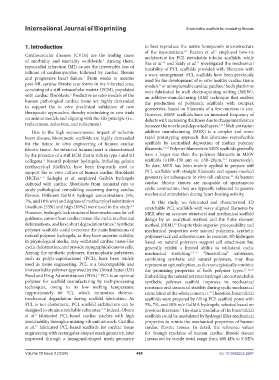Page 477 - IJB-10-3
P. 477
International Journal of Bioprinting Stretchable scaffold for modeling fibrosis
1. Introduction to best reproduce the native honeycomb microstructure
of the myocardium. Paxton et al. employed bow-tie
9
6,7
Cardiovascular diseases (CVDs) are the leading cause architecture for PCL stretchable tubular scaffolds, while
of morbidity and mortality worldwide. Among them, Bas et al. and Saidy et al. investigated the mechanical
1
11
10
myocardial infarction (MI) causes the irreversible loss of tunability of PCL scaffolds provided with filaments with
billions of cardiomyocytes, followed by cardiac fibrosis a wavy arrangement. PCL scaffolds have been previously
and progressive heart failure. From weeks to months used for the development of in vitro healthy cardiac tissue
1
post-MI, cardiac fibrotic scar forms in the infarcted area, models or as implantable cardiac patches. Such platforms
6
11
consisting of a stiff extracellular matrix (ECM), populated were fabricated by melt electrospinning writing (MEW),
with cardiac fibroblasts. Predictive in vitro models of the an additive-manufacturing (AM) technique that enables
2
human pathological cardiac tissue are highly demanded the production of polymeric scaffolds with complex
to support the in vitro preclinical validation of new geometries, based on filaments of a few microns in size.
therapeutic approaches, thereby minimizing in vivo trials However, MEW scaffolds have an increased frequency of
on animal models and aligning with the 3Rs principle (i.e., defects with increasing thickness due to charge interference
replacement, reduction, and refinement). between the nozzle and deposited layers. 12,13 Melt-extrusion
Due to the high socioeconomic impact of ischemic additive manufacturing (MEX) is a simpler and more
heart disease, biomimetic scaffolds are highly demanded rapid prototyping approach that fabricates reproducible
for the future in vitro engineering of human cardiac scaffolds by controlled deposition of molten polymer
fibrotic tissue. An infarcted human heart is characterized filaments. 14,15 Polymer filaments in MEX scaffolds generally
by the presence of a stiff ECM that is rich in type I and III have a larger size than the polymer filaments in MEW
3,14
collagens. Natural polymer hydrogels, including gelatin scaffolds (≥100–150 µm vs. ≤50–20µm, respectively).
2
methacryloyl (GelMA), have been frequently used to To date, MEX has been mainly applied to prepare stiff
support the in vitro culture of human cardiac fibroblasts PCL scaffolds with straight filaments and square-meshed
16
(HCFs). Sadeghi et al. employed GelMA hydrogels geometry for subsequent in vitro cell cultures. As human
5–8
cultured with cardiac fibroblasts from neonatal rats to cardiac fibrotic tissues are incapable of spontaneous
study pathological remodeling occurring during cardiac cyclic contraction, they are typically subjected to passive
fibrosis. Different GelMA hydrogel concentrations (5%, mechanical stimulation during heart-beating activity.
7%, and 10% w/v) and degrees of methacryloyl substitution In this study, we fabricated and characterized 3D
(medium [53%] and high [81%]) were used in the study. 3,4 stretchable PCL scaffolds with wavy aligned filaments by
However, hydrogels lack structural biomimetic cues for cell MEX after an accurate structural and mechanical scaffold
guidance, cannot bear cardiac tissue-like cyclic mechanical design by an analytical method and the finite element
deformations, and have short degradation times. Synthetic method (FEM). Despite their superior processability and
5
18
polymer scaffolds could overcome the main limitations of mechanical properties over natural polymers, synthetic
natural polymer hydrogels, as they have superior stability polymers lack cell adhesive cues. In contrast, 3D hydrogels
in physiological media, may withstand cardiac tissue-like based on natural polymers support cell attachment but
cyclic deformation, and provide topographical cues to cells. generally exhibit a limited ability to withstand cyclic
Among the synthetic polymers, thermoplastic polyesters, mechanical stretching. 19–21 “Bioartificial” substrates,
such as poly(ε-caprolactone) (PCL), have been widely combining synthetic and natural polymers, may thus
used in tissue engineering. PCL is a biocompatible and represent an optimal option, as they synergistically combine
bioresorbable polymer approved by the United States (US) the promising properties of both polymer types. 17–21,25
Food and Drug Administration (FDA). PCL is an optimal Embedding the natural polymer hydrogel into a stretchable
3
polymer for scaffold manufacturing by melt-processing synthetic polymer scaffold improves its mechanical
techniques, owing to its low melting temperature resistance and structural stability during cyclic mechanical
(approximately 60 °C), which minimizes thermo- stimulation of the whole construct. Therefore, bioartificial
19
mechanical degradation during scaffold fabrication. As scaffolds were prepared by filling PCL scaffold pores with
PCL is not elastomeric, PCL scaffold architecture can be 5%, 7%, and 10% w/v GelMA hydrogels, selected based on
designed to obtain stretchable substrates. Indeed, Olvera previous literature. The elastic modulus of the bioartificial
5–8
3
et al. fabricated PCL-based cardiac patches with high scaffolds could be modulated by hydrogel filler mechanical
6
stretchability through a missing-rib unit network. Castilho properties to mimic the mechanical properties of human
et al. fabricated PCL-based scaffolds for cardiac tissue cardiac fibrotic tissues. In detail, the reference values
12
engineering with rectangular-shaped mesh geometry, later for Young’s modulus of human cardiac fibrotic tissues
improved through a hexagonal-shaped mesh geometry (measured by tensile tests) range from 400 kPa to 9 MPa
Volume 10 Issue 3 (2024) 469 doi: 10.36922/ijb.2247

